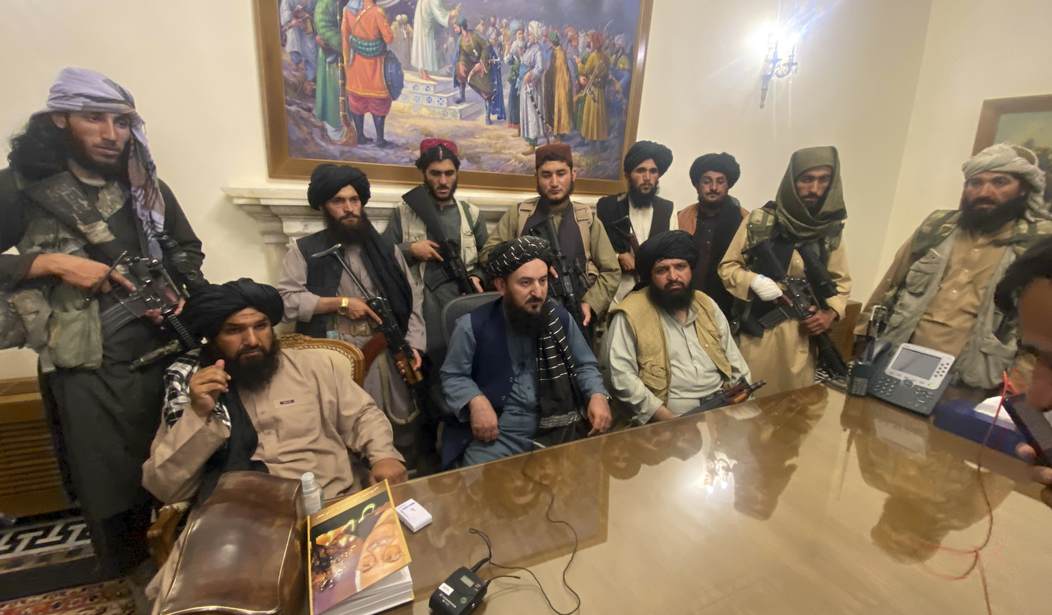Today, we remember the horrific attacks of Sept. 11, 2001, and the thousands of Americans killed by Islamic terrorists linked to Al-Qaeda and led by Osama bin Laden. On September 20, 2001, President George W. Bush demanded that the Taliban in Afghanistan turn over bin Laden and other Al-Qaeda leaders. When they refused, the U.S. and British forces invaded Afghanistan on October 7, 2001, with the express purpose of removing the Taliban from power. Coalition forces had captured Kabul by November, and Kandahar fell on December 6, 2001. This defeat officially ended the Taliban’s rule.
Now, on September 11, 2021, the Taliban again sits in the Presidential Palace in Kabul. Their triumphant return occurred as the United States was still attempting to evacuate our embassy, hundreds of American citizens, green card holders, and thousands of Afghan allies who had assisted coalition forces over the last 20 years. The chaotic and embarrassing withdrawal included the deaths of 13 Marines and hundreds of Afghans at the Abbey Gate at the Hamid Karzai International Airport.
Following the suicide bombing at the gate, America launched two drone attacks. The first was outside Kabul, which the Biden administration claimed took out an ISIS-K “planner” and his associate. There are still no details on who these reportedly high-value targets were. The second took place in a residential neighborhood, supposedly taking out the threat of a vehicle bomb at the Kabul airport. The military insists this was a legitimate strike. However, The New York Times is reporting something different.
The strike took place in the courtyard of a residential neighborhood and killed 43-year-old Zemari Ahmadi, two other adults, and seven children. According to the family, the man was an aide worker who spent the hours before he died running errands. The Pentagon claims Ahmadi was a facilitator for the Islamic State, and that he had packed his car, destined for the Kabul airport, with explosives.
Ahmadi was an electrical engineer by training. For 14 years, he worked for a California-based non-governmental organization (NGO) that established soybean manufacturing plants and undertook other activities to fight malnutrition. The white Toyota Ahmadi drove, which was destroyed by the bomb, was a company car. The day the drone strike killed him, he had picked up several coworkers to drive to NGO’s office.
According to the Times investigation, using security and aerial footage to track Ahmadi’s movements, Ahmadi had filled containers with water. A water shortage in his neighborhood necessitated him bringing water home from his office. His visit to a Taliban office was to get permission to deliver food to a displacement camp, as the NGO had been doing for years. The “compound” the Pentagon says the car had pulled into was the NGO office. The Pentagon claims the containers contained explosives.
The Pentagon says their footage showed the men putting packages into the car. The men who survived said those were laptops, which the video shows them carrying. When Ahmadi arrived home, the children in his family surrounded his vehicle, as was customary, according to his brother. That’s when the drone struck. The Pentagon claims the civilian deaths were the result of large secondary explosions.
Recommended: Two Decades Later: 9/11 Lessons Learned and Ignored
The Times had military experts review images from the explosion site, and they said it was consistent with the Hellfire missile the Pentagon claims to have used. However, they saw no evidence of powerful secondary blasts. Shortly after the drone strike that killed Ahmadi, someone launched rockets at the airport from a neighborhood Ahmadi had driven through earlier in the day.
The Pentagon admits they had no information about Ahmadi before the strike. A few days prior, the NGO he worked for had applied for refugee resettlement in the U.S. for Ahmadi and his family. On the day he and other family members were killed, they were still waiting for approval.
When we left Afghanistan, President Biden assured Americans that we had the tools and capability to ensure Afghanistan would not become a terrorist haven. He bragged that we had “over the horizon” capability to take out terrorist targets as required. According to the Times investigation, we did not even have that capability with boots on the ground.
Terrorists with millions of dollars in bounties placed on them by the U.S. government are in leadership positions in Afghanistan’s new government. The State Department says we can’t vet potential evacuees, leading to delays for civilian-led evacuation efforts by air. We can’t vet our own citizens and allies, yet we are supposed to believe we can take out terrorist cells from afar? The U.S. likely droned an aide worker and his family because they confused his vehicle with someone else’s from a few kilometers away.
Related: Taliban Planning to Steal Joe Biden’s 9/11 Anniversary Thunder
And while we are being told that the Afghan Army had cut and run, the acting president and national forces are still fighting in the Panjshir Valley. They are receiving no U.S. support from the air. According to journalist Lara Logan, Al-Qaeda forces, Pakistani terrorists, and terrorist groups from other areas of the Middle East support the fight with the Taliban in this region. If this region falls, it will be the first time in decades. Panjshir had remained free of Taliban and even Russian control in previous conflicts.
On “Tucker Carlson Tonight” Friday, Jaeson Jones, a former captain with the Texas Department of Public Safety’s Intelligence and Counter-Terrorism Division, said we have a six- to eight-week window before the chaos in Afghanistan arrives at our southern border. His organization, Omni Intelligence, monitors the situation at the border to inform the public and our government about emerging threats.
Jones said there has been an uptick in migration from the region through a well-established pattern. Migrants leave Afghanistan and head to Brazil from Saudi Arabia or Qatar. Then they take the same routes north that so many other migrants are traveling. Traffic from Afghanistan has been increasing with the U.S. withdrawal. Jones asserted that our advanced operations south of the border charged with identifying potential threats are overwhelmed by the surge in migrant traffic through Darien Gap in Central America. The whole world, including our enemies, knows it.
Twenty years later, the same threats that burst out of the Middle East are brewing again. The vocal support from China makes the situation even more complex. Every American should be asking what the Biden administration will do to contain the threats and protect our borders. Insisting that the Taliban form an “inclusive” government is not going to fix it.
WATCH the entire New York Times report:










